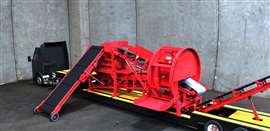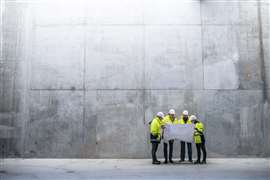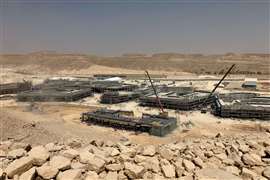Opinion: Faster shredder head replacement can reduce downtime
15 October 2025
Custom recycling systems specialist BCA Industries argues that swapping out a rebuilt shredder head in as little as one hour can keep production running, minimise downtime and labor costs, and restore the system to full functionality
 Swapping out a rebuilt shredder head in as little as one hour keeps production running while restoring the system to full functionality. (Photo: BCA Industries)
Swapping out a rebuilt shredder head in as little as one hour keeps production running while restoring the system to full functionality. (Photo: BCA Industries)
Swapping out a rebuilt shredder head in as little as one hour keeps production running, minimizing downtime and labor costs, while restoring the system to full functionality.
In high-output shredding operations, equipment downtime is one of the most significant threats to productivity and profitability.
Nowhere is this more apparent than in the maintenance of shredder heads, the core mechanical assemblies in industrial shredders responsible for the material reduction process.
These heads, composed of rotating shafts, knives, bearings, and hydraulics, endure extreme mechanical loads and high-torque conditions, and knife wear can cause both failures and low production.
Traditional methods for restoring shredder heads to full functionality typically involve extensive and costly rebuilds that result in substantial operational downtime.
Rebuilding a shredder head presents a complex challenge that demands specialized expertise, precision tools, and strict adherence to tight engineering tolerances. Issues such as misalignment, incorrect knife gaps, and overlooked wear points can result in reduced performance or early failure.
Internal rebuilds can fall short due to a lack of specialized equipment or training, increasing the likelihood of operational issues post-reassembly. The resulting downtime, combined with the labor and logistical costs of a full rebuild, places a heavy burden on operators.
As a result, some processors are shifting their strategy away from in-house or third-party rebuilds in favor of complete shredder head swaps. This approach can significantly reduce downtime—often restoring machines to full function in under an hour—and ensures that rebuilt components meet OEM specifications.
“Instead of navigating the challenges of disassembly and reassembly, operators can perform a quick head replacement and immediately resume production, maintaining uptime and minimizing disruption,” says John Neuens, Industrial Consultant at BCA Industries, a Milwaukee-based OEM specializing in custom recycling systems.
The swap-and-go methodology can reduce the need to retain specialized technicians on-site, reduce the risk of rebuild errors, and offer a more predictable maintenance cycle. Ideally, the process should include a factory warranty when factory rebuilt.
In-house or third party rebuilds
Although some processors believe they can effectively disassemble and reassemble the unit themselves, the process is complex and requires specialized knowledge, custom-built jigs and fixtures to assist with disassembly and reassembly, and adherence to strict tolerances to ensure proper function and longevity.
“Despite their outwardly rugged appearance, shredders are precision-engineered machines with tightly controlled tolerances that must be maintained to achieve effective and consistent material shearing,” says Neuens.
“Most of our knives are an AR500 base alloy, super abrasion resistant, with a hard-face welded edge. It can be difficult just finding a knife rebuild service to rebuild them correctly, much less a technician who has the skills needed in the shredder business.”
Disassembly introduces additional complications, as components are frequently dirty, worn, or corroded, often requiring forceful removal.
Even seemingly simple tasks, such as assessing the condition of components like bearings and keyways, require experience, as factors like grease line condition play a role in the success or failure of a rebuild.
While OEMs like BCA offer instructional videos to walk customers through the head rebuilding process, Neuens says these videos typically can range from two to three hours in length given the complexity and variables involved.
After viewing the video, many customers ultimately choose not to undertake the work themselves.
“Most processors do not have the in-house resources to complete this work to specification, and hiring a qualified mechanic or millwright is costly. At the same time, most independent shops are not equipped to meet the required standards,” says Neuens, adding that even when the work is performed by the OEM’s technicians, shredder head repairs and part replacements can take 16 to 40 hours to complete.
Quick shredder head swap-out
As a cost-effective option, some operators are using modular shredder head designs and professional rebuild programs to reduce downtime and extend equipment lifespan, including models such as the ES1000, PD1000, Triplus, and The Beast 2000 series.
These modular designs allow a worn shredder head to be replaced quickly, sometimes in under an hour. In some cases, operators maintain a second head to enable continuous production while repairs, such as knife replacement, are performed offline or at a professional rebuild facility.
During professional rebuilds, shredder heads are fully disassembled, cleaned, inspected, and reassembled with adjustments based on field performance data.
Knives may be re-sharpened, hard-faced, and re-ground, while spacers, bearings, chains, and other worn components are replaced as needed.
Shafts, keys, sprockets, and other critical parts are checked, and tolerance verifications are carried out to ensure the rebuilt head meets or surpasses original specifications. Any design improvements developed since the original build can also be applied.
Once rebuilt, heads are returned to the operator for reinstallation. The units are designed to be manageable with standard lifting equipment and can typically be installed with minimal connections.
Shredder head rebuilds continue to be one of the most persistent and costly maintenance challenges in the industry. These rebuilds are both time-consuming and expensive, often occurring at highly inconvenient times.
The shredder head and knife maintenance is responsible for approximately 90% of the total lifetime maintenance cost, establishing it as the most significant wear component in the system.
For industry professionals, swapping out shredder heads instead of rebuilding them offers a smarter, more efficient path forward. Instead of sinking time and money into repeated, time-consuming rebuilds, they can minimise downtime, reduce maintenance costs, and keep production running smoothly with ready-to-go replacement heads.
STAY CONNECTED



Receive the information you need when you need it through our world-leading magazines, newsletters and daily briefings.
CONNECT WITH THE TEAM











